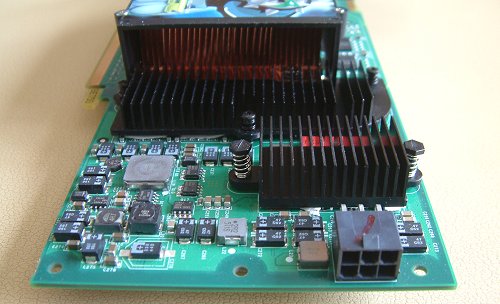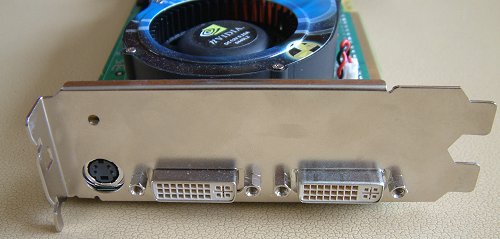Card appearance

The first thing you notice, when handling the card, is just how large the PCB is. It's an inch or so wider than a GeForce 6800 Ultra equipped with 256MB of onboard RAM. The extra width taken up by additional power regulation components on the 512MB XFX model. Being a GeForce 6800 Ultra and presented in PCI-Express, you can run two of these cards in SLI mode for extra frame-rate fun.

XFX's 512MB-equipped GeForce 6800 Ultra runs at 430MHz core and 1050MHz RAM. Its core, then, is 5MHz faster than most Ultras but its RAM is run 50MHz slower. Ceteris paribus, we expect it to benchmark at the same kind of levels as a regular 256MB card, assuming the 512MB framebuffer doesn't impact on performance too greatly. There's an array of power-related components that you don't find on a 256MB GeForce 6800 Ultra, thus explaining why this card requires more PCB space. The cooler used on this 512MB card is also a touch different to most 256MB-equipped Ultras. For one, the heatsink doesn't cover the RAM chips on either side. We would have hoped that XFX skipped the 512MB reference design and use a custom cooler, taking into account passive RAM cooling.

A beefy cooler gives rise to a card that takes up both a single PCIe x16 slot and the next available slot to the right. The introduction of the faster, single-slot GeForce 7800 GTX highlights that superlative performance needn't be accompanied overbearing cooling. This is where all 6800 Ultras look poor in direct comparison, and XFX's, sadly, is no exception. Dual-DVI outputs are expected, and the S-Video socket is good for outputting video to external displays. There's no VIVO functionality on this model either.
One feature that separates 512MB-equipped cards over their 256MB GeForce counterparts is the introduction of a professional-class dual-link DVI connection, as well as a regular single-link. Dual-link DVI, using two TMDS transmitters, allows you to run monitors with resolutions in excess of 1920x1200. We're thinking of something along the lines of Apple's breathtaking 30-inch Cinema Display, which runs at a native 2560x1600. XFX's card can run it off a single dual-link DVI port, naturally.

4 DRAM devices on the back complement the 4 on the front. Compared to ATI's 512MB card implementation, NVIDIA/XFX opt for density over number. 256MB Ultras still sport 8 DRAM devices, located solely on the front. Samsung's 1.6ns-rated 512Mbit devices that are split between the front and rear of the card. XFX tows NVIDIA's 512MB framebuffer company line by running memory at 1050MHz. The problem with specifying DRAM with such high density is cost, pure and simple. XFX's very own 256MB GeForce 6800 Ultra PCI-Express card, running at similar frequencies to this 512MB model, can be purchased for around £340. Adding in another 256MB pushes this card's cost up to £470, which is, rather unfortunately, above GeForce 7800 GTX (256MB) pricing.
Taking into account the GPU and memory speeds on XFX's 512MB GeForce 6800 Ultra, the extra £130 outlay above a 256MB Ultra needs to be justified by better performance at high I.Q. settings. We'll investigate if it is.









